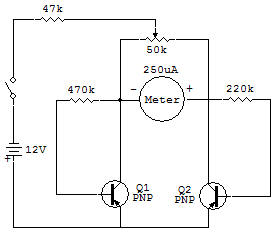
Hygrometer (Relative Humidity Gauge)

The purpose of this project is to construct and study a Hygrometer. A Hygrometer is an instrument used to measure the relative humidity in the air.
This is generally done by comparing the readings from two identical thermometers: one with a dry bulb, and one with the bulb dampened with water. As the water evaporates it cools the dampened thermometer.
The relative humidity is indicated by the difference in the two temperature readings (using a chart). As you might suspect, the drier the air, the faster the water will evaporate. The faster the water evaporates, the more it cools the thermometer. Therefore, more difference in the two temperature readings indicates a lower relative humidity.
We use the two 2SA Transistors as thermometers in our hygrometer (look at project Electronic Thermometer in transistor section, if you've forgotten how this works). They are connected so that the difference in their outputs (C-E current) will control the base current of the 2SC Transistor, and therefore the Meter reading (the current flow in the C-E circuit of the 2SC).
The steps for operating this Hygrometer are as follows:
1) After the wiring is complete, adjust the Control so that the Meter has a reading of exactly 10.
2) Without touching a terminal or the 'bread board', wrap a damp piece of cloth around the lower 2SA Transistor.
3) The Meter pointer will move to a lower reading to indicate the relative humidity.
Note:
If the temperature around is low, the Meter change will be slight. If the temperature is high, the Meter change will be greater.
